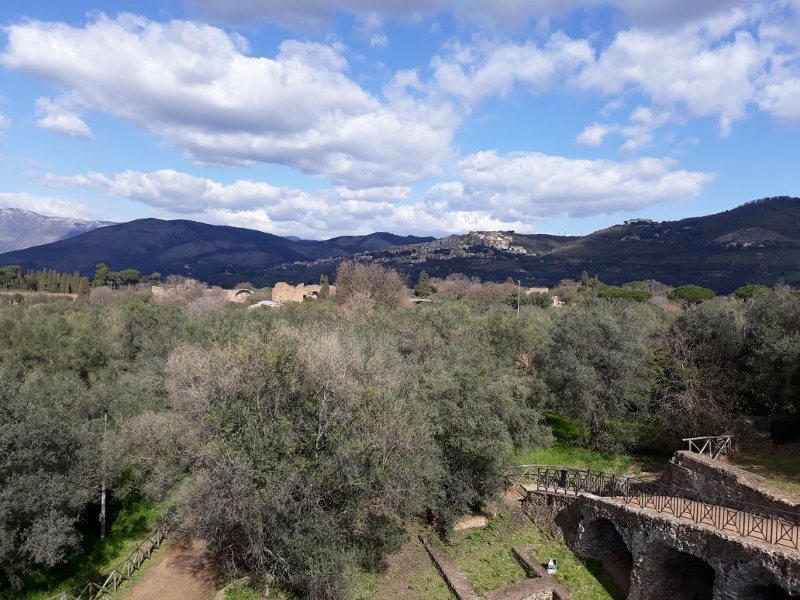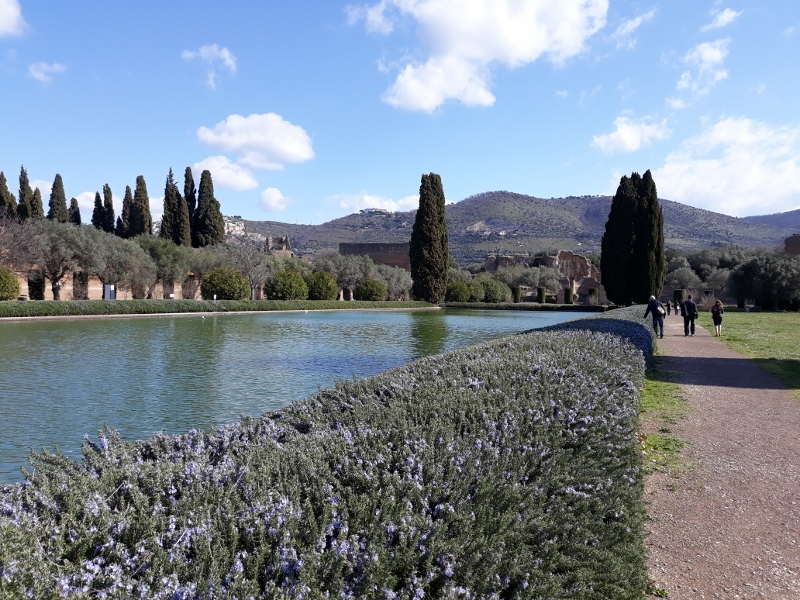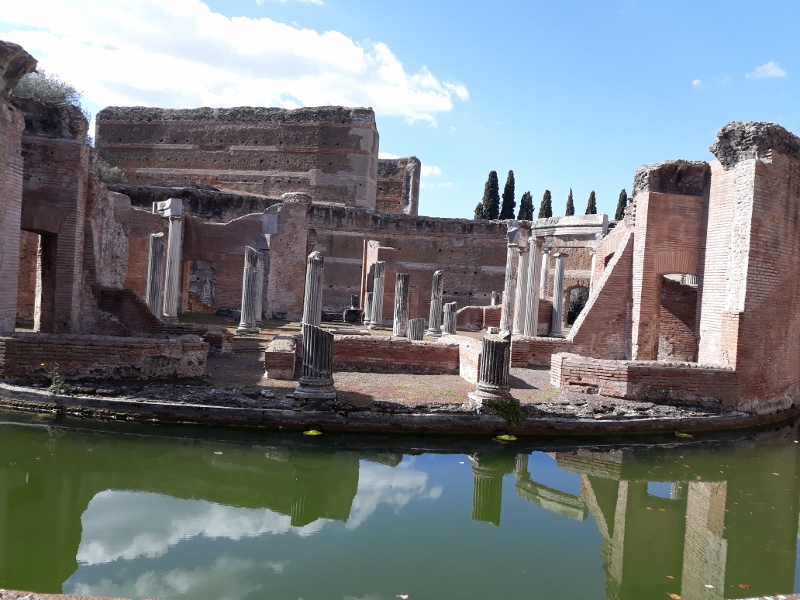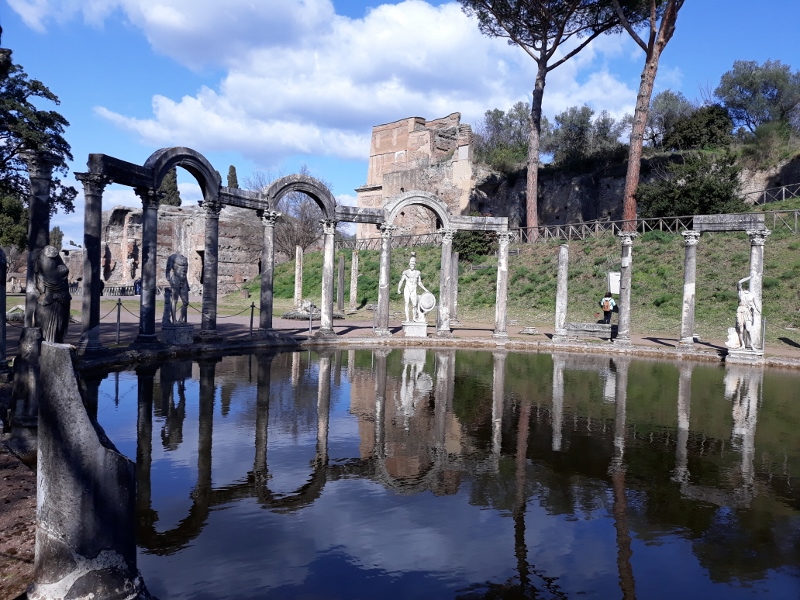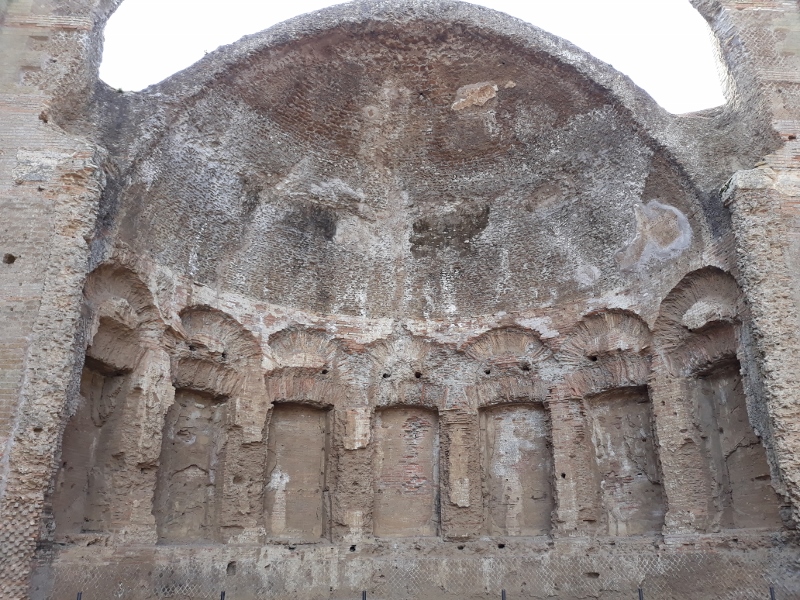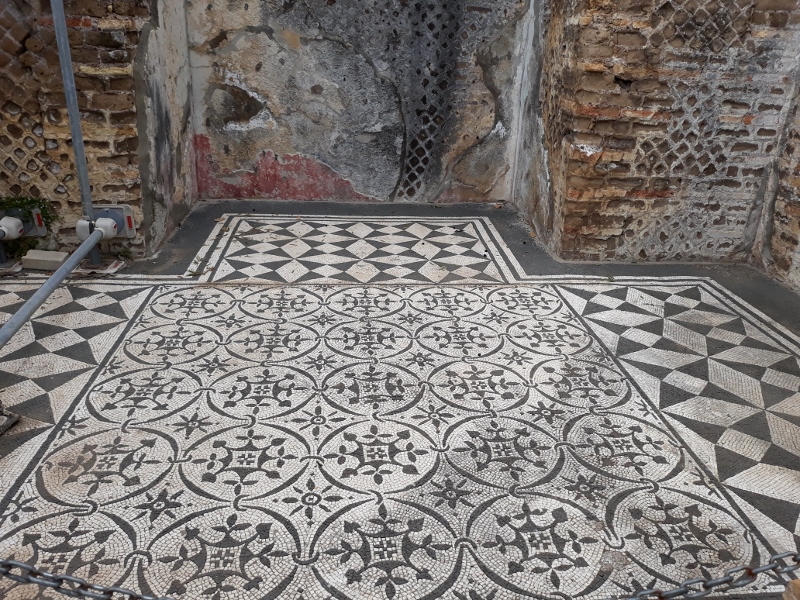Durante il mio soggiorno a Roma ho effettuato una gita fuori porta di una giornata per visitare Villa Adriana a Tivoli. Dalla fermata di Piazza della Repubblica a Roma ho preso la metropolitana in direzione Rebibbia ed alla fermata Ponte Mammolo ho proseguito con un autobus della linea Co.Tra.L. In circa 40 minuti sono arriva a Tivoli e sono scesa ad una fermata lungo la via Tiburtina; con una piacevole passeggiata di mezz’ora sono giunta al sito archeologico, situato alle pendici dei monti Tiburtini.
Hadrian’s Villa in Tivoli
During my stay in Rome I went on a day trip out of town to visit Hadrian’s Villa in Tivoli. From the Piazza della Repubblica stop in Rome I took the underground to Rebibbia and at the Ponte Mammolo stop I continued on the Co.Tra.L bus line. In about 40 minutes I arrived in Tivoli and got off at a stop in via Tiburtina; with a pleasant half-hour walk I reached the archaeological site, located on the slopes of the Tiburtini mountains.
Qualcuno potrebbe pensare che siano solo rovine e pietre prive di significato. Eppure ciò che vediamo oggi è solo una minima parte di un enorme complesso, che costituiva una vera e propria città. Fu fatta costruire fra il 118 ed il 134 d.C. dall’imperatore Adriano, che scelse l’antica città di Tibur, l’odierna Tivoli appunto, come luogo ideale per la sua residenza imperiale extraurbana, a circa trenta chilometri da Roma, in un ambiente tranquillo e rilassante.
Someone might think that they are just meaningless ruins and stones. Yet what we see today is only a small part of a huge complex, which was a real city. It was built between 118 and 134 AD. by emperor Hadrian, who chose the ancient city of Tibur, today’s Tivoli, as the ideal place for his extra-urban imperial residence, about thirty kilometres from Rome, in a peaceful and relaxing environment.
Il sito offre molti scorci suggestivi della campagna, oggi coltivata ad ulivi, e delle colline circostanti, che spuntano tra le colonne e gli altri resti. La villa è testimonianza non solo di un periodo di grande potenza e splendore dell’impero romano, ma anche dell’amore di Adriano per la cultura, l’arte e l’architettura, tanto da essere divenuta Patrimonio Unesco nel 1999. Molti dei luoghi della villa prendono ispirazione da quanto Adriano ammirò durante i suoi frequenti viaggi e presentano quindi anche elementi architettonici tipici dell’Egitto e della Grecia.
The site offers many suggestive glimpses of the countryside, now planted with olive trees, and of the surrounding hills, which appear among the columns and other remains. The villa bears witness not only to a period of great power and splendour of the Roman Empire, but also to Hadrian’s love for culture, art and architecture, so that it became a UNESCO World Heritage Site in 1999. Many of the places of the villa are inspired by what Hadrian admired during his frequent journeys and therefore also have architectural elements typical of Egypt and Greece.
La ricchezza d’acqua del territorio fu uno dei motivi della scelta di costruire qui la villa; essa costituiva una grande risorsa per i Romani per la cura del corpo e per scopo ornamentale, per cui era una presenza importante, visibile ancor oggi in alcuni dei luoghi iconici e più suggestivi della villa.
The abundance of water in the area was one of the reasons for choosing to build the villa there; it was a great resource for the Romans for body care and for ornamental purposes, therefore it was an important presence, still visible today in some of the iconic and most evocative places of the villa.
La visita inizia dal Pecile, un imponente quadriportico che prendeva il nome dal Portico dipinto, centro della vita culturale di Atene; esso delimitava un giardino ed una vasca centrale, e la sua posizione era ideale per passeggiare sia d’estate che d’inverno, ammirando il panorama della campagna romana.
The visit starts from the Pecile, an imposing quadriportico which took its name from the painted Portico, the centre of cultural life in Athens; it bordered a garden and a central basin, and its position was ideal for walking both in summer and in winter, admiring the view of the Roman countryside.
Le terme erano una consuetudine per gli antichi Romani; vi erano addirittura tre stabilimenti per gli ospiti ed il personale della villa. Le Piccole Terme erano probabilmente riservate alle donne, mentre le Grandi Terme agli uomini. La tipica struttura era composta dalla sala per i bagni freddi, quella per i bagni caldi ed altri ambienti per i trattamenti di benessere, attività ginniche e di svago. Esse testimoniano anche l’elevata competenza ingegneristica nel sistema idraulico e di riscaldamento, di cui sono rintracciabili alcuni resti.
The baths were a custom for the ancient Romans; there were even three establishments for the guests and the staff of the villa. The Small Baths were probably reserved for women, while the Big Baths for men. The typical structure consisted of a room for cold baths, one for hot baths and other rooms for wellness treatments, gymnastic and leisure activities. They also prove the high engineering competence in the hydraulic and heating system, of which some remains can be traced.
Il terzo complesso termale apparteneva al Palazzo Imperiale, il cuore dell’intera villa, la residenza di Adriano. Oggi di questa residenza sono visibili i resti della Piazza d’Oro, la Sala dei pilastri dorici (dove si amministrava la giustizia), la caserma dei vigili (un edificio che ospitava il corpo di guardia), ed il quadriportico con peschiera per i pescatori ospitati nella villa.
The third thermal complex belonged to the Imperial Palace, the heart of the whole villa, Hadrian’s residence. Today you can see the remains of the Piazza d’Oro, the Hall of Doric pillars (where justice was administered), the policemen’s barracks (a building that housed the guardhouse), and the quadriportico with fishpond for fishermen hosted in the villa.
L’edificio con tre esedre conduceva all’ingresso del Palazzo Imperiale; il nome deriva dalle strutture incave semicircolari, chiamate esedre, dotate di sedili e che si affacciavano sulle sale delle case signorili greche e romane. Parte dell’edificio costitutiva l’atrio del Palazzo, mentre un’altra zona era destinata a banchetti ed eventi ufficiali.
The building with three exedras led to the entrance of the Imperial Palace; the name comes from the semicircular hollow structures, called exedras, which had seats and overlooked the rooms of the Greek and Roman stately homes. Part of the building was the atrium of the Palace, while another area was intended for banquets and official events.
Il Teatro Marittimo, così chiamato da una decorazione che rappresentava un soggetto marino, era una piccola residenza – secondo alcuni il nucleo primitivo della villa – , dove l’imperatore si ritirava per trascorrere del tempo in tranquillità. Esso sorge su un’isoletta di forma circolare ed è reso particolarmente affascinante per gli elementi architettonici che si riflettono nel canale d’acqua che corre tutto intorno.
The Teatro Marittimo, so called because of a decoration that depicted a marine subject, was a small residence – according to some the original nucleus of the villa – where the emperor retired to spend some time in peace. It stands on a small circular island and is made highly fascinating by the architectural elements reflected in the water channel that runs all around.
Il Canopo è un grande bacino d’acqua e prende nome dal canale che collega l’omonima località egiziana situata sul delta del Nilo alla città di Alessandria. Esso ricorda anche la triste vicenda di Antinoo, un giovane egiziano a cui l’imperatore era molto legato e che morì annegato proprio nelle acque del Nilo. Passeggiando intorno si ammirano le numerose statue (tra cui delle copie delle cariatidi dell’Eretteo di Atene), gli archi e le colonne che lo impreziosiscono; alla sua estremità, una grande nicchia semicircolare chiamata Serapeo (dal nome del tempio egiziano dedicato alla divinità Serapide) doveva essere una grande sala da pranzo per feste e banchetti in estate.
The Canopus is a large water basin and takes its name from the canal that connects the homonymous Egyptian town located on the Nile delta to the city of Alexandria. It also recalls the sad story of Antinous, a young Egyptian to whom the emperor was very close and who drowned in the waters of the Nile. Walking around you can admire the many embellishing statues (some are copies of the caryatids of the Erechtheion in Athens), arches and columns; at its end, a large semicircular niche called the Serapeum (from the name of the Egyptian temple dedicated to the divinity Serapis) may have been a large dining room for parties and banquets in the summer.
Il richiamo alla sapienza ed alla cultura è presente in alcuni luoghi come la sala dei filosofi, probabilmente sede delle riunioni della corte imperiale; il nome viene dalle statue dei sette sapienti che erano destinati ad occupare le nicchie presenti nella sala. Vi era anche un piccolo teatro greco riservato ai membri della corte, di cui rimangono parte della platea e del proscenio; infine gli edifici gemelli della biblioteca greca e la biblioteca latina.
The reference to wisdom and culture is present in some places such as the philosophers’ hall, probably the seat of the meetings of the imperial court; the name comes from the statues of the seven wise men who were destined to occupy the niches in the room. There was also a small Greek theatre reserved for court members, of which part of the stalls and proscenium remain; finally the Greek library and the Latin library twin buildings
Ciò che oggi rimane è sufficiente a farci immaginare come doveva essere bella la villa. Non è difficile chiudere gli occhi e vedere gli antichi Romani in questi ambienti decorati con affreschi colorati e rivestiti con marmi ed altri materiali pregiati. Alcune tracce sono ancora oggi visibili, come ad esempio il rivestimento a mosaico con forme geometriche degli Hospitalia, stanze adibite a dormitori. Ed ancora, giardini, fontane, ninfei e giochi d’acqua che hanno poi ispirato le grandi ville rinascimentali.
What remains today is enough to make us imagine how beautiful the villa must have been. It is not difficult to close your eyes and see the ancient Romans in these rooms decorated with colourful frescoes and covered with marble and other precious materials. Some traces are still visible today, such as the mosaic with geometric shapes covering the Hospitalia, rooms used as dormitories. Moreover, gardens, fountains, nymphaeums and water features that later inspired the great Renaissance villas.
Purtroppo, dopo la decadenza dell’impero romano, la villa subì diversi saccheggi, perdendo così molti di questi elementi. Solo dal ‘500 essa fu riscoperta e divenne oggetto di studio da parte di molti umanisti. Dobbiamo dire grazie a colui che ci ha tramandato un dono di così grande valore da un passato così lontano; se oggi possiamo ammirarlo è grazie agli studi ed agli scavi, tuttora in corso, volti ad identificare il ruolo degli ambienti ed a riportare alla luce nuove testimonianze.
Unfortunately, after the decline of the Roman Empire, the villa was sacked several times, thus losing many of these elements. It was only from the 1500s that it was rediscovered and was studied by many humanists. We must say thanks to the one who handed down to us a gift of such great value from such a distant past; if we can admire it today it is thanks to the studies and excavations, still in progress, aimed at identifying the role of the rooms and bringing new evidence to light.
